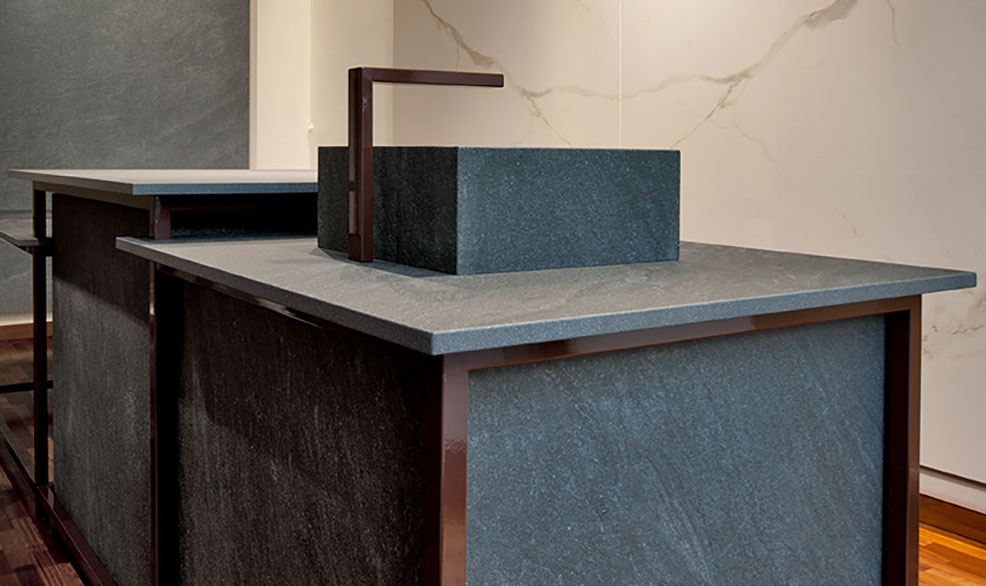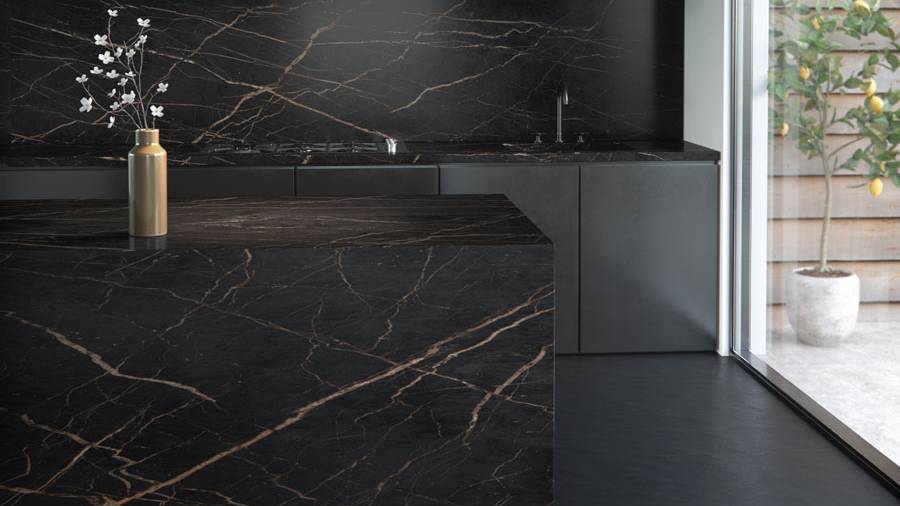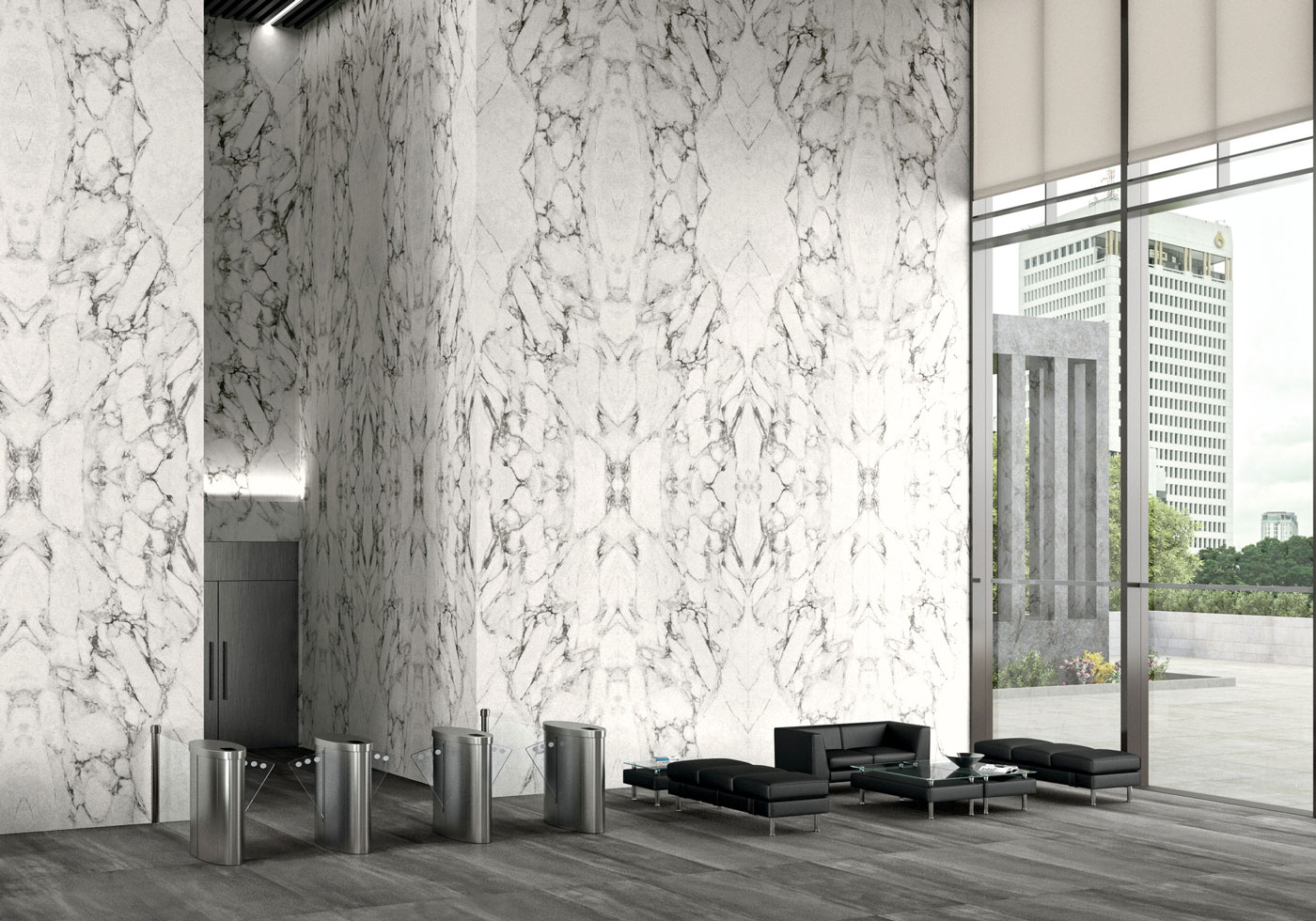The Skinny on Ultra-Thin
Walls and Floors? Yes. Countertops? Well ....
Above: MSI Stile® Statuario Bari. Previous page: Dekton® Slim Rem
By K. Schipper
If the last few years in this industry have been about anything, it’s new materials. While granite and marble will never be out-of-date, every week seems to bring new products to market with promises of better performance and/or lighter weight, with a look that’s “just like” the popular natural flavor of the moment. One of the noticeable changes with the new products is that many of them are being sold in thicknesses that are nowhere near the standard 2cm and 3cm of natural stone. If this were a limbo contest, the question would be: How low can they go? The answer: pretty low. Slab-sized ultra-thinpanels are avaible from familiar stone partners such as MSI (Stile® collection), Cosentino (Dekton® Slim) and Dal-Tile (Panoramic series), along with notable tile producers such as FLORIM, Iris Ceramica, Laminam, Atlas Concorde, Lapitec and others. And, porcelain is starting to get some competition from other hard surfaces, such as Cambria's recent introduction of a range of 6mm quartz-surfaces.
However, the reality is these thin products aren’t for every job, and for the stone shop hoping to add some new products to the repertoire, it’s probably a good time to brush up on some tile cutting and installation skills.

6mm or 12 mm slabs/tiles "can be as easy as working with regular granite, quartz or porcelain products,”
Raul Amat
National Manager, Gauged Porcelain Dal-Tile Corporation

Laminam: Pietra di Cardoso Nero Fiammato
"We’ve tried it several different ways; a countertop needs to be sturdy and all suggested methods of installation that our installers tried do not guarantee long-term success."

Piergiorgio Mazzetta
CEO Laminam USA and Laminam Canada
The main appeal of these products is as a veneer. Just as a host of thin-veneer natural stones have made life easier for those installing architectural stone, these <1cm products often show up as a replacement for tradition tile or stone applications. “Our materials are used in interior walls, fireplaces, exterior cladding applications and even furniture,” says Piergiorgio Mazzetta, Vaughan, Ont.-based CEO of Laminam USA and Laminam Canada. “They can be used for floors, but they should not be used at less than 5-6mm.” Pablo Navarro Rodriguez, product trainer and support specialist for the Coral Gables, Fla.-based Cosentino North America, says that company’s Dekton® Slim provides the same benefits as a thicker slab of the material, while being lightweight enough for more creative applications. “Designers and architects have found myriad ways to use Dekton Slim,” he says. “Popular applications include furniture, and cabinetry doors and drawers, as well as backsplashes and wall claddings for kitchens and baths.” For Roy Viana, director of natural stone and slab for Dallas-based Dal-Tile Corporation, the other bit of appeal with products such as his company’s Panoramic Porcelain Surfaces is their large format – 10’ 7” X 5’ 4” – makes them especially appealing for areas with big square-footage needs.
“The large-format size, combined with the fashion-driven designs and color options available, lets designers and homeowners achieve seamless, continuous design,” Viana says. “These large-format porcelain slabs especially satisfy big square footage needs such as residential hallways or grand commercial reception areas.” Where the jury is still out is on whether these products can be used for countertops. Both Mazzetta and Navarro Rodriguez say the answer is a definite “no,” at least for now. “We’ve tried it several different ways, a countertop needs to be sturdy and all suggested methods of installation that our installers tried do not guarantee long-term success,” says Laminam’s Mazzetta. “I would not suggest it. I believe that 5-6mm are more for surfacing use rather than structural use. If you want to do a countertop, use 12mm or 20mm.” “Dekton Slim is not recommended for countertops,” echoes Navarro Rodriguez. “However, we will have a solution for this soon.” However, Dal-Tile’s Viana says not only can its Panoramic products create beautiful kitchen islands with minimal or no seams, but they hold up well to the wear and tear of family life. That company’s Raul Amat, the national manager of gauged porcelain, says it’s more common to use its 12mm (1.2cm) slabs in countertop and vanity applications. “The use of backerboards will not be mandatory but it will always be recommended,” says Amat. “That’s especially true for installation projects where there’s not enough support.” He adds that it’s always important to use approved backerboards since using certain materials with high coefficient-of-expansion-and-contraction won’t be recommended.

Cosentino: Dekton® Slim Laurent
"Designers and architects have found myriad ways to use Dekton Slim. Popular applications include furniture, as well as backsplashes and wall claddings for kitchens and baths."

Pablo Navarro Rodriguez
Product Trainer and Support Specialist Cosentino North America
“The use of backerboards will not be mandatory but it will always be recommended,” says Amat. “That’s especially true for installation projects where there’s not enough support.” He adds that it’s always important to use approved backerboards since using certain materials with high coefficient-of-expansion-and-contraction won’t be recommended.“
Regardless the type of job it’s destined for, these ultra-thin slabs offer their own challenges in handling. As many shops have learned to their detriment, the lack of thickness doesn’t provide the same amount of support a regular slab does, making them hard to lift and move. “Working with and fabricating our Panoramic Porcelain slabs in either 6mm or 12mm in either a tile or slab format can be as easy as working with regular granite, quartz or porcelain products,” says Amat. “It’s true that fabrication techniques, production processes and the necessary tooling are all slightly different than those used on other category products, though.” Both Laminam’s Mazzetta and Cosentino’s Navarro Rodriguez recommend starting with the right equipment to move the slabs. “If conventional stone manipulation tools are used, they can exceed the flexibility limit of the material and cause fissures or breakages,” says Navarro Rodriguez.
“Suction cups are fundamental and vacuum lifting devices, in particular, are good solutions,” says Mazzetta. One Dal-Tile suggestion is to replace granite clips with glass lifter attachments, which will also reduce the chance of chipping during transportation. Amat urges shops interested in getting into this market segment to read the company’s technical manual on the product, take the time to receive proper training, and to always work to ANSI (American National Standard Institute) standards. As for fabrication, it can be a snap – literally. “Working with 6mm Panoramic Porcelain panels and tiles for flooring and vertical applications is very simple,” says Amat. “Some special tooling such as suction cups or cutting tables for score-and-snap might be required depending on the size of the tile to be installed, but the rest of the tooling and thin-set materials would be similar to the ones used to install smaller-size porcelain tile.” “Score-and-snap is a fast and clean technique used to fabricate Dekton Slim,” agrees Navarro Rodriguez.“Suction cups are fundamental and vacuum lifting devices, in particular, are good solutions,” says Mazzetta.

Daltile: Panoramic Porcelain Gypsum Calacatta
"These large-format porcelain slabs especially satisfy big square footage needs such as residential hallways or grand commercial reception areas."

Roy Viana
Director of Natural Stone and Slab Dal-Tile Corporation
While polished straight edges are popular with many applications, there are times when a mitered edge would be preferred, and Navarro Rodriguez says mitering can be easier than with a thicker material. “The easiest way is doing it with a Makita or similar grinder,” he says. “They have equipment that can be mounted to the same rail that you’re using for the score-and-snap. The equipment tilts to different angles which makes it easier to miter the material.” Laminam’s Mazzetta says the work can be done either manually using a grinder installed on a rail or using CNC machinery. He adds that Laminam’s advantage is that unlike other materials it manufacturing process doesn’t leave it with the tension that requires a fabricator to do relief cuts. Once the preferred edge is finished, these ultra-thin pieces can be mounted on a host of backing materials. “The nature of the substrate will change based on the application,” says Mazzetta. “For exterior cladding such as a rain screen, it will be aluminum extrusions and structural sealants; for floors it will be a screed; for walls it could be drywall, and for exterior walls it could be cement boards.”
He adds that these materials are a natural solution for installations on top of existing substrates without performing demolitions, but the situation must be assessed professionally. Installation requires a few simple steps, says Navarro Rodriguez. They include cleaning the back of the piece and the substrate; checking to make sure the pieces and the substate are level; drawing guidelines on the support and; double gluing each piece. “Use a notched trowel to create parallel lines,” he says. “The direction of the pattern should span across the shorter length of the piece. The pattern on the piece and support must follow the same direction and not cross.” The decision to use mortar or adhesive on a particular project depends mainly on the application. For cladding applications, Cosentino’s Navarro Rodriguez suggests checking with the product’s manufacturer. Dal-Tile’s Amat concurs. “Our porcelain slabs can be used on many different applications, and different mortars or adhesives will be recommended for every specific project,” Amat says.
